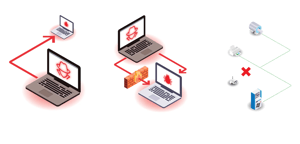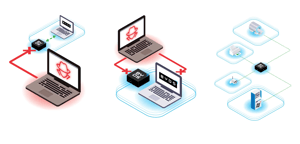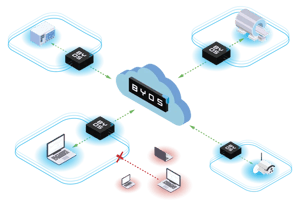
Before & After BYOS
The most effective way to secure your network is to make every device undiscoverable and inaccessible - that's entirely new!
| BYOS lets you monitor and control the traffic at the outer edge, physically stopping attacks before they reach the asset. | BYOS runs independently from the asset and OS, providing a stronger containment strategy against attacks. | BYOS delivers device and OS-agnostic protection, minimizing the attack surface and broadening the coverage area. |

Before

After
Become Invisible
They can't target what they can't see!
BYOSwerx makes your assets invisible to the network they are connected to, even if the device’s network addresses and identities are known, automatically isolating them from attacks.

No Compromises
Access everything without allowing access to anything.
BYOSwerx allows you to access any asset remotely, from and to uncontrolled networks. Simultaneously, those assets don’t have access to anything, are protected, and are invisible to the local network.

The BYOS Difference
Do you rely on VPNs to protect remote workers?
BYOS
VPN
BYOS is about protection, control and access
Is just about access
BYOS Secure Edge protects the endpoint and the traffic
Protects the traffic, not the endpoint
Protects both inbound and outbound traffic, and won't respond to unsolicited requests, dropping them at the edge
Only projects outbound traffic
Makes the endpoint invisible on the network, isolating it from networking attacks like fingerprinting, enumeration, scanning, DDos, exploiting, etc.
Can encrypt the outbound traffic successfully, but it will still be fooled by network attacks
Doesn't depend on the OS, therefore can't be bypassed/evaded
Depends on (and is controlled by) the OS
Provides route enforcement so that all endpoint traffic passes through it
The OS can still communicate from outside the VPN
Prevents traffic leakage until the Secure Lobby connection is established
Endpoint leaks traffic until the VPN is established
Access Control is enforced at Layer 2 and granular by nature - Secure Lobby On/Off + port/service control
Access control within VPNs is enforced at Layer 7 and too broad (on or off)
Automates key management
Require key and config management/exchange with the end-user
Protection is decentralized, and enforced at each Secure Edge
Are heavily dependent on the remote VPN Terminator
